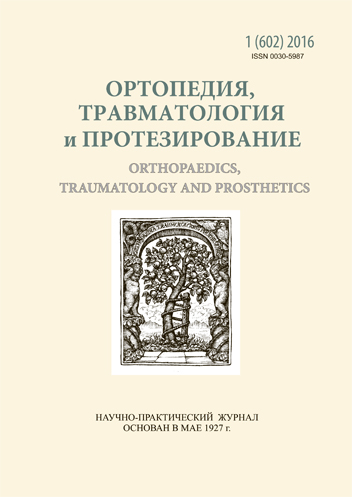State of venous blood flow in the lower extremitiesof patients with fractures of the tibia after plate osteosynthesis
DOI:
https://doi.org/10.15674/0030-59872016150-53Keywords:
fractures of long bones of the lower leg, metalosteosynthesis, on-bone plate, deep vein thrombosis, blood flow disturbanceAbstract
Violation of antegrade blood flow, deep vein thrombosis and pulmonary embolism (PE) presents the complex problem in the treatment of trauma patients.
The goal: to examine the state of antegrade blood flow in the vessels of lower extremities in patients with fractures of the long bones of lower leg after surgery using on-bone plates.
The methods: clinical-laboratory and Doppler study of 56 pa-tients (33 men and 23 women aged from 19 to 62 years) were performed. Fractures in the lower third of the tibia were found in 17 (30.3 %) patients, in the middle third — in 29 (51.7 %), at the top — in 10 (18 %). All patients at different times after injury underwent an open reduction and fixation of bone fragments of leg bones with LCP-plates. The patients, who had such pathology as chronic thrombophlebitis, cardiovascular or cancer diseases, overweight or had a history of episodes of pulmonary embolism (PE) before injuries were not included in the study.
Results: it was found that surgical treatment provokes considerable disturbances in the hemostatic system with the development of deep vein thrombosis of the injured limb. After the surgery, a positive test for D-dimer and a significant increase in the level of soluble fibrin-monomer complex was observed in 34 (60.7 %) patients, that was almost twice the number of such cases in preoperative period. Thrombosis of shin venous on the level of surgery with signs of flotation and proximal distribution was revealed on Doppler ultrasound investigation. Conclusions: the patients who have undergone surgery to stabilize bone fragments using LCP-plates, are at risk of pathological thrombus formation in the veins of the operated limb and the need for timely diagnosis and adequate treatment of this disease in order to avoid dangerous complications such as thrombotic disease of the lower extremities and pulmonary embolism (PE).
References
- Zhuk PM, Sarkhan KhA. The risk of deep venous thrombosis in bone fractures of the lower limbs at an early stage of development of traumatic disease. Visnyk ortopedii, travmatolohii ta protezuvannya. 2010;3:70–9.
- Anderson FA, Spencer FA. Risk factors for venous thromboembolism four topics in venous thromboembolism. Circulation. 2003;107:1–9.
- Zhuk PM, Sarkhan KhA. Deep vein thrombosis of the lower limbs in traumatology and orthopedics. Visnyk ortopedii, travmatolohii ta protezuvannya. 2010;2:67–70.
- Pisarev V, Lviv SE, Kutareva OI, Molchanov OS. Features antegrade blood flow and venous thrombotic complications in patients with fractures of the hip and thigh. Traumatologiya i orthopediya Rossii. 2009;2(52):33–8.
- Rogers FB, Osler TM, Shackford SR. Immediate pulmonary embolism after trauma: case report. J Trauma. 2000;48(1):146–8.
- .Zhuk PM, Sarkhan KhA, Lazarenko YuV, Fomyn AA. Informative ultrasound in detecting DVT in the lower extremities fractures. Visnyk morfologii 2010;16(1):200–1.
- Barden B, Kroger K, Loer F. Intraoperative Doppler ultrasound of the femoral vein for maintaining venous patency in hip joint prosthesis implantation. J Der. Unfallchirurg. 2001;104(2):138–42.
- Righini M, Perrier A, Moerloose PDE, Bounameaux H. D–Dimer for venous thromboembolism diagnosis: 20 years later. J Thromb Haemost. 2008;6(7):1059-71. doi: 10.1111/j.1538-7836.2008.02981.x.
- Zhuk PM, Sarkhan KhA, Lazarenko YuV, Fomyn AA. Prognostic significance of D–dimer in the diagnosis of thrombosis in the diagnosis of deep vein thrombosis of the lower extremities in trauma practice. Visnyk Vinnytskogo Natsionalnogo medychnoho universytetu. 2010;14(1):207–8.
Downloads
How to Cite
Issue
Section
License
Copyright (c) 2016 Dmitro Babun, Petro Zhuk

This work is licensed under a Creative Commons Attribution 4.0 International License.
The authors retain the right of authorship of their manuscript and pass the journal the right of the first publication of this article, which automatically become available from the date of publication under the terms of Creative Commons Attribution License, which allows others to freely distribute the published manuscript with mandatory linking to authors of the original research and the first publication of this one in this journal.
Authors have the right to enter into a separate supplemental agreement on the additional non-exclusive distribution of manuscript in the form in which it was published by the journal (i.e. to put work in electronic storage of an institution or publish as a part of the book) while maintaining the reference to the first publication of the manuscript in this journal.
The editorial policy of the journal allows authors and encourages manuscript accommodation online (i.e. in storage of an institution or on the personal websites) as before submission of the manuscript to the editorial office, and during its editorial processing because it contributes to productive scientific discussion and positively affects the efficiency and dynamics of the published manuscript citation (see The Effect of Open Access).














